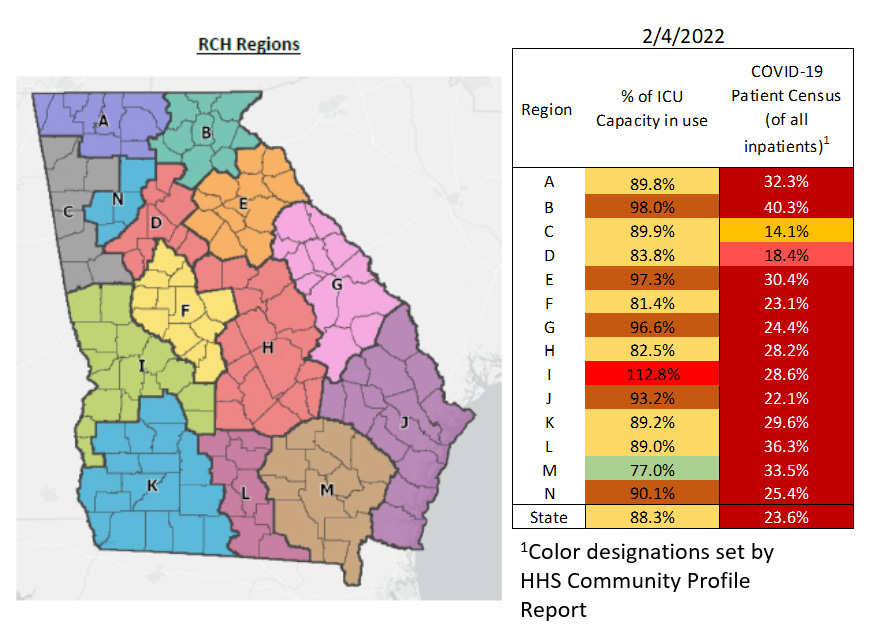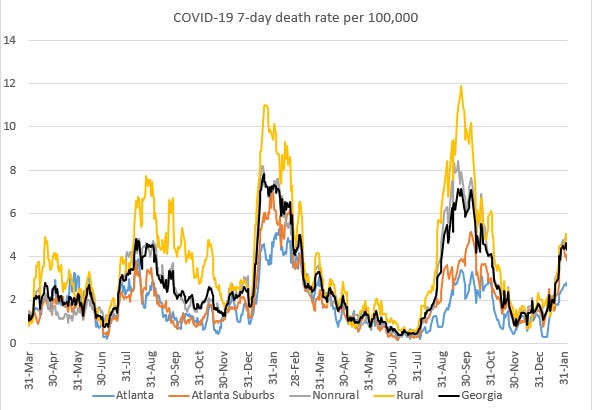This week’s Digest is going to focus on two areas:
National trends
Omicron’s impacts in different parts of Georgia
The Omicron wave continues to recede in all regions of the country, yet disease rates are still higher than they ever were prior to Omicron. Things are still pretty dangerous for those who are immunocompromised or with underlying medical conditions. Below, you can see how new case rate had changed for all the regions of the US since the start of the pandemic. The graph comes from the Department of Health and Human Services Community Profile Report from 03Feb2022. The national case rate remains 51% higher than the previous record, set in January 2021.
So even though things are much better than they were last month, they are still quite intense throughout the country. Still, we see that some of the areas are starting to emerge.
However, hospital admissions haven’t descended as rapidly as cases. That’s not altogether surprising, since it can take some time for a person to become sick enough to need a hospital bed. Hospitalization rate continues to be highest in the South, but the rate is decreasing for all regions.
The top ten states or US territories for each of the following metrics are shown below, sorted from highest to lowest. So for the first four columns, the areas listed are where disease is the most intense. For vaccination rate, it’s a good thing to have a high number. So these are areas that have done well to establish some level of population-level immunity through vaccination. These data also come from the HHS Community Profile Report.
Georgia
I’d like to next talk about Georgia. This week, the case total dropped below the previous peaks set by the winter 2020-2021 and Delta waves.
Hospital admissions are slower to come down, which is consistent with what’s been happening regionally and nationally. Even though there have been differences in the case peaks, the hospitalizations peak at about the same place since the summer 2020 surge. I think this has to do with the idea that you can have as many cases as you want, but there are only so many hospital beds and people to staff them.
ICU admissions rose 32% this week and deaths were about the same as the previous week. ICU bed usage and COVID-19 patient census for each hospital region in the state are shown below.
The Omicron wave started in Atlanta and then fanned out throughout the state. Much of the state’s case growth and hospitalization numbers were based on what was happening in Atlanta (hospital region D). However, Atlanta is seeing a relatively modest rise in death rate compared to the rest of the state. This could be attributable to higher vaccination rates, possibly better adherence to public health guidance, proximity to hospitals and healthcare, etc.
In fact, the counties that consistently had the highest death rate through every surge have been rural ones. And now, the rural death rate is once again the highest in the state. Below, you can see that the cumulative death rate in rural counties is more than twice as high as that in Atlanta counties (Fulton and DeKalb).
I’d like to take a deeper look at the regions that were hit hard previously by Delta compared to others. The area that was hardest hit was region J, Savannah and coastal Georgia. Its COVID-19 patient census graph is shown below. We can see that the Delta wave of summer and fall 2021 was more than twice as intense as the previous waves. There were about 6 months between these two peaks and the Omicron peak was 45% less than the Delta peak.
Region K is in the southwest corner of Georgia (see graph below). It is home to Albany, Georgia and other cities, that was at one time the most intense COVID-19 hotspot in America in spring 2020. After that huge first wave the summer surge was mild by comparison. Then they had subsequently bigger waves for winter 2020-2021 and Delta, which set the region’s record. They didn’t see as much of a possibly protective effect from the Delta wave as region J. Instead, their Omicron peak was only 12% less than the Delta peak.
Whereas the Atlanta metro largely sat out of previous surges, they were the epicenter of the Omicron surge. Don’t get me wrong, Atlanta saw case and hospitalization numbers rise, but not nearly so intensely as other regions of the state. The Atlanta metro is made up of two hospital regions: D and N. Region N is the Northwest Atlanta suburbs. The graph for region N is shown below.
Region N has set large peaks since the winter of 2020 - 2021. But they didn’t get the protective effect from Delta that Region J saw with Omicron. Instead, they set a new record for COVID-19 patient census, even though Delta also set a record previously. Lastly, let’s consider hospital region D, Atlanta.
For region D, Omicron shattered all previously set records. Atlanta had a Delta surge though not as intense as in other areas. Omicron’s peak was 57% higher than for Delta.
I bring all of this to your attention because we’re hearing the same chorus of skeptics that we’ve heard as we descend from every previous surge. “This was the big one” and “the pandemic is over” and “it’s time to move on.” And yet, the next surge is sometimes bigger than the one before it. These skeptics have been wrong, repeatedly, and people die as a result of the policy changes they champion. As we still have low vaccination rates in parts of the United States and across the world, we will continue to have these surges that cause widespread disruption. We should be using the descent from this wave and the lull that will exist until the next one to prepare. We should be doing all that we can to solidify and strengthen healthcare systems and staffing, to improve indoor air quality, and to improve vaccination rates. COVID-19 seems to have two seasons - summer and winter - when temperatures are uncomfortable enough to drive people to gather indoors. Let’s wait to declare “victory” over a virus that continually evolves until we see a wave that doesn’t dwarf the one that preceded it. We know the things that work against this virus but there has been little political will and leadership to implement those things. So we all suffer for it. COVID-19 has two seasons. Let’s prepare for summer to be rough. If it isn’t, then maybe we are turning the corner on this pandemic. But I would be wary of anyone who tells you this is over.
A virus that “isn’t real” or “is mild” has now killed 900,000 Americans in less than two years. Let me be very clear that it is NOT NORMAL to see 900,000 people die from a disease that we can prevent.
This week, there was a new report of a pediatric death in Georgia. He was a fifteen year old boy from Long County. His is one of 26 pediatric deaths to date associated with COVID-19. Of all the pediatric deaths that have been reported to date, 73% were among children of color. It is not normal for children to die. Stop attempting to normalize this.
It’s crazy to hold the two ideas in your head at once: that the disease is no big deal and that 900,000 people have died of it. Or that we should go back to normal while we are setting records for daily death count. It does make you wonder what is wrong with people. How are they able to be okay with both of those ideas?
Keep reading with a 7-day free trial
Subscribe to The COVID Digest to keep reading this post and get 7 days of free access to the full post archives.















